1993 CHEVROLET CORVETTE steering
[x] Cancel search: steeringPage 83 of 370

Downloaded from www.Manualslib.com manuals search engine ..a
Features & Controls
Turn Signal/Headlight Beam
Lever
The lever on the left side of the steering
column includes your:
. Turn Signal and Lane Change
4 Headlight 'High-Low Beam Changer
Windshield Wipers
Windshield Washer
Cruise Control
The High-Low Beam feature is
discussed under
HeadZights. See the
Index under Headlights.
Indicator
32
E
Turn Signal and fane Change
Indicator
The turn signal has two upward (for
Right) -and two downward (for
Left)
positions. These positions allow you to
signal a turn or a lane change.
TO signal a turn, move the lever all the
way up
01- down. When the.turn is
finished, the lever will return
automatically.
A green arrow on the instrument panel
will flash in the direction af the turn or
lane change.
To signal
a lane change, just raise or
lower the lever until the-green arrow
starts
to flash. Hold it there until you
complete your lane change. The lever
will return
by itself when you release it.
As you~ignal a turn or a lane change, if
the arrows don't flash but just stay on, a
signal bulb may be burned out and
other drivers
won't see your turn signa1.
If a bulb is burned out, replace it to help
avoid .an accident. If the green
arrows
don't-go on at all when you signal a
turn, check the fuse (see the Index
under Fuses G Circuit Breizkers) and
for burned-out bulbs.
A warning chime will remind you if you
have left your turnsignal cm for more
than 1 mile (1.6 km) 'of driving.
Page 100 of 370
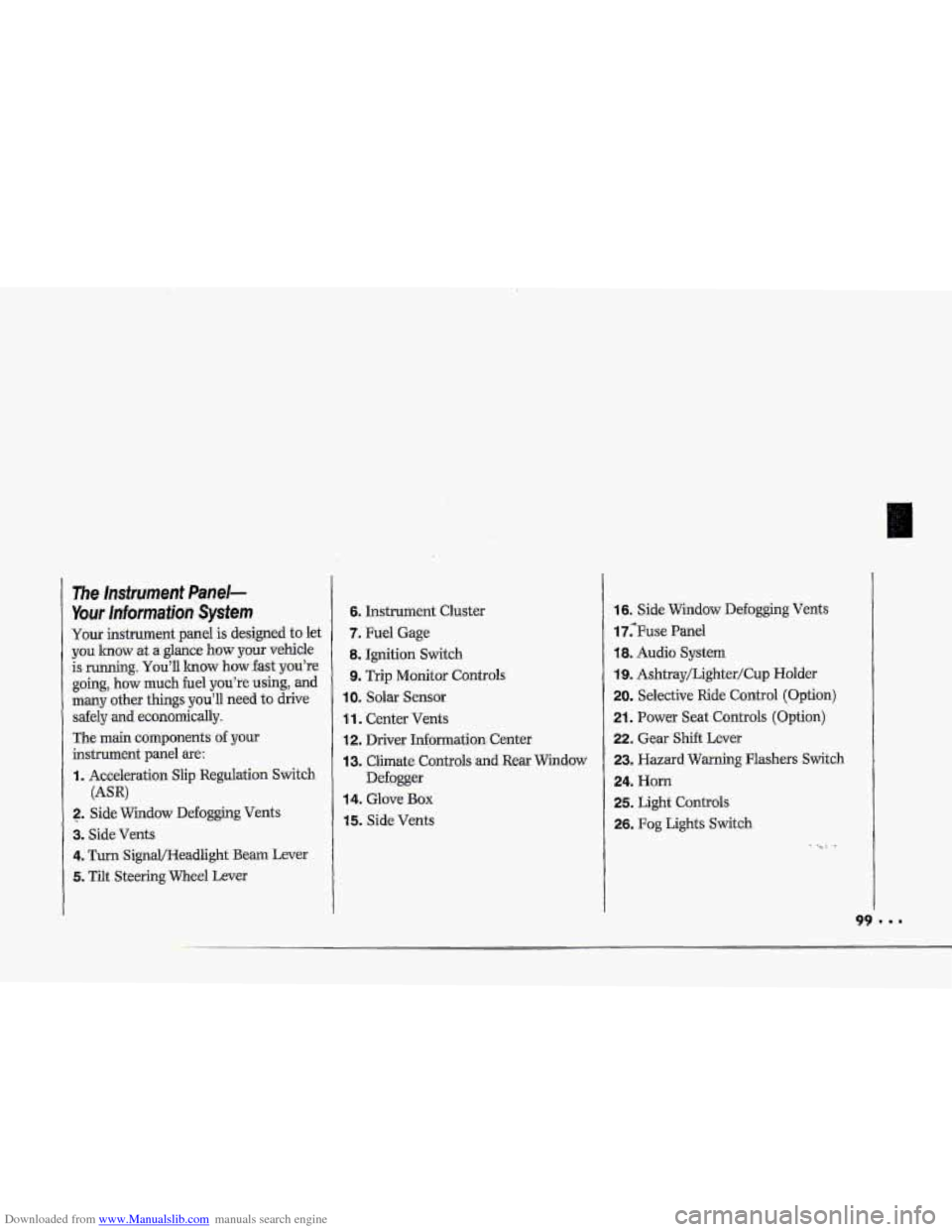
Downloaded from www.Manualslib.com manuals search engine i
P
r
F"
i I
The Insfrument Panel-
Your lnformaiion System
Your instrument panel is designed to let
you lmow at a glance how your vehicle
is running.
You'll lrnow how fast you're
going, how much fuel
you're using, and
many other things you'll need to drive
safely
and economically.
The main components
of your
instrument panel are:
I. Acceleration Slip Regulation Switch
2. ,Side Widow Defogging Vents
3. Side Vents
4. Turn SignQHeadlight Beam Lever
5. Tilt Steering Wheel Lever
(AW
6. Instrument Cluster
7. Fuel Gage
8. Ignition Switch
9. Trip Monitor Controls
IOm Solar Sensor
1 1. Center Vents
12. Driver Information. Center
13. Climate Controls and Rear Window
Defogger
14. Glove Box
15. Side Vents
16. Side Window Defogging Vents
17;Fuse Panel
18. Audio System
19. Ashtray/Lighter/Cup Holder
20. Selective Ride Control (Option)
21. Power Seat Controls (Option)
22. Gear Shift Lever
23. Hazard Warning Flashers Switch
24. Horn
25. Light Controls
26. Fog Lights Switch
-. .
Page 164 of 370
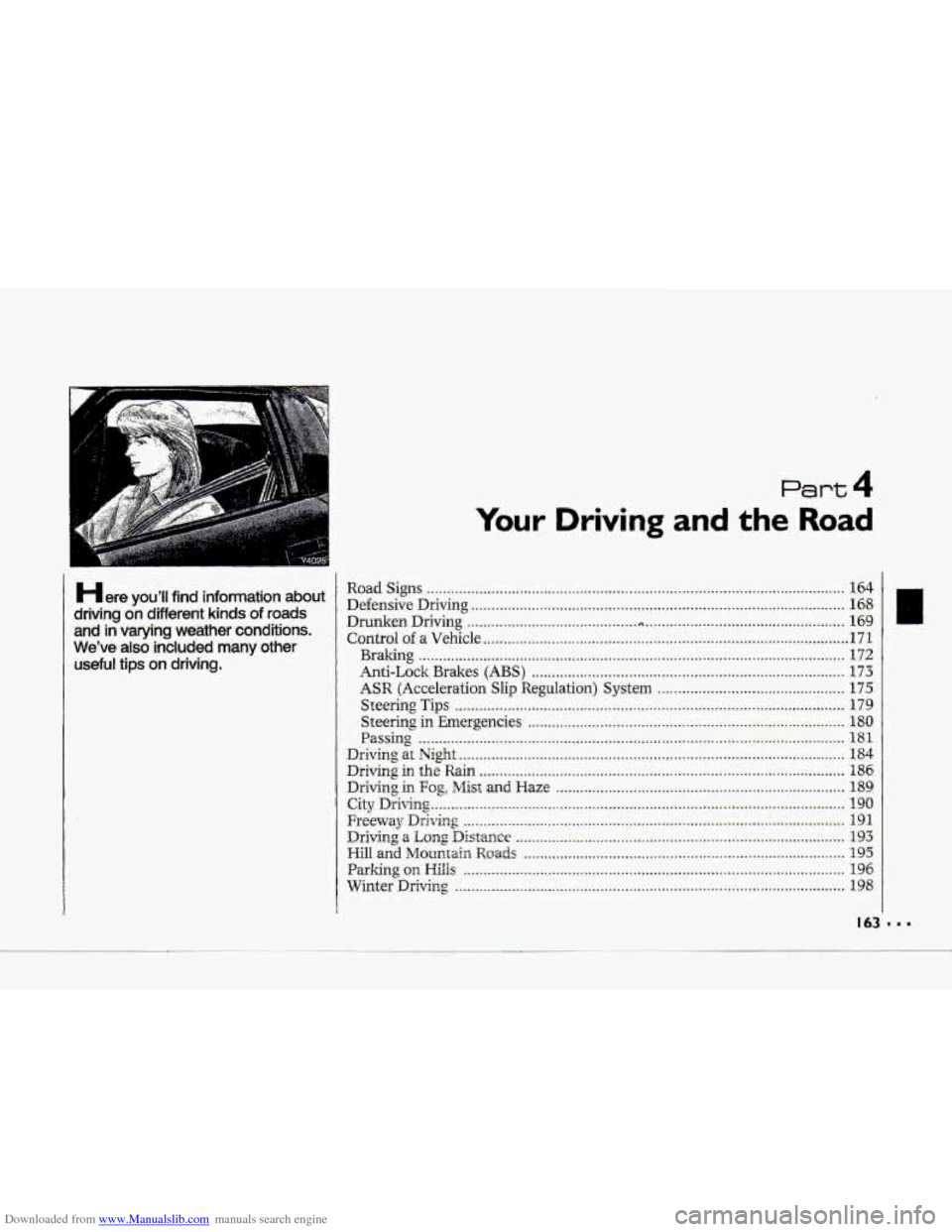
Downloaded from www.Manualslib.com manuals search engine R-
Here you'll find .information about
ddvmg on different kinds of ro.ads
and in varying weather conditions.
We've also included many other
useful tips on driving.
Part 4
Your Driving and the Road
Road Signs .. . ... . . . . .. ..... . . ,... . .. . . . .. . _. . . .. . . . . . .+. . . . . . ... . .. .. . . . . . . . . . . ... .. . . . . . . .. . . . . . . ... . .. . .... . . . . 164
Defensive Driving. . .... . . . . . . . .... . . .. . . . . &. . . . .. . ... . . . .. .. . . . . . , . . . . . . . +. . . , . , -. . . . . . . . . . . . . . . . . . . . .*. . .+ ... 168
Drunken Driving . . . . . . . . . -. . . . . . . . . . -. . . . . . . . . . . . . .I +, . , . . *. . . . . , , . . . . . . . . . , . . . . . . . . . . . . . . . . . . . ... . <.. . . . . . . . 169
Control.:of a Vehicle .. . . . . . . . . . .. . . . . . . . . . . . . . . . . . ... . . . . , . . , +. . .. . . . . . . _. . . . . . . *. . .. . . . . . . . . . . . . .. . . ... . .. . .. 17 1
Braking ........................................................................\
................................... 172
hti-Lock Brakes (ABS) ..................~.........,...........................................\
.. '.. 173
ASR (Acceleration Slip Regulation) System .............................................. 175
Steering Tips .. .. . . .. . . ... . . . . . . . . . .. . .. . . . . . . . . . . . . . . . . ._. . . . . . . . . . . . , . . ... . . . . , . . . *. . -, . , , . . . , , , , . . . ... . . , . . 179
Steering in Emergencies .... -. . . ?. . . . . , .. .. .. . . . . . . . . . . ... . . . . . . , . . . . , . . . ... . . .. .. . . . ..-. - ..... ..-. .. . . -180
Driviqp Mght ........................................................................\
......... .....,......... 184
Driving in the kin ..._....,....... .....+... +.... ......... + ................................................. 186
Driving-in Fog, Misl and Haze .... . . ._.._. . . . . . . . . . . . , . . , . . . . . . ... . . .+_. . . . . . . . . . .. . . . . . . . . . . . . . . . . . . 189
City Dnvi~i.lng _._..._.I.._._..__.___ _.___: ... ._ _.__. ............ ... . . ... .. .............. . .... . ........................ 190
-Freeway Dnvang __. . . . .. _._ ._. __. .__ . . . . -. . .. . __._ . . . . . . . . . . . . . . . ... . . . . . . -. . . . . . . . . . . . . . . . . . . . . .. . .. . .-. . ... . . 19 1
Driving a Long Distance ._ ._ _. __._ ._ _._ . . .. . . . . -. . . . . . . . . . . . . . . . . . . . . . . . -. .. . . . -.-._. . . ... . . _. . . . . . .. . . . ... . 193
Hill and hiloramai~ Rmds ........................................................................\
........ 195
Parking on Hills. I..X.1.........__.l.....I..............................................~\
...................... 196
Winter Driving __ ..._.._____... ._. ._ ._. ._. .. . ..... .. . . .. . ... . . . . . . . . . . . .... . . . . . . . . . . . , . , . . . . . . . . . . . . . .... . . . . 198
Passing *I*..* ..................................................................... -: ......... a. ..i;..i.r- .e... ;... 181 7,
2.. .
Page 179 of 370
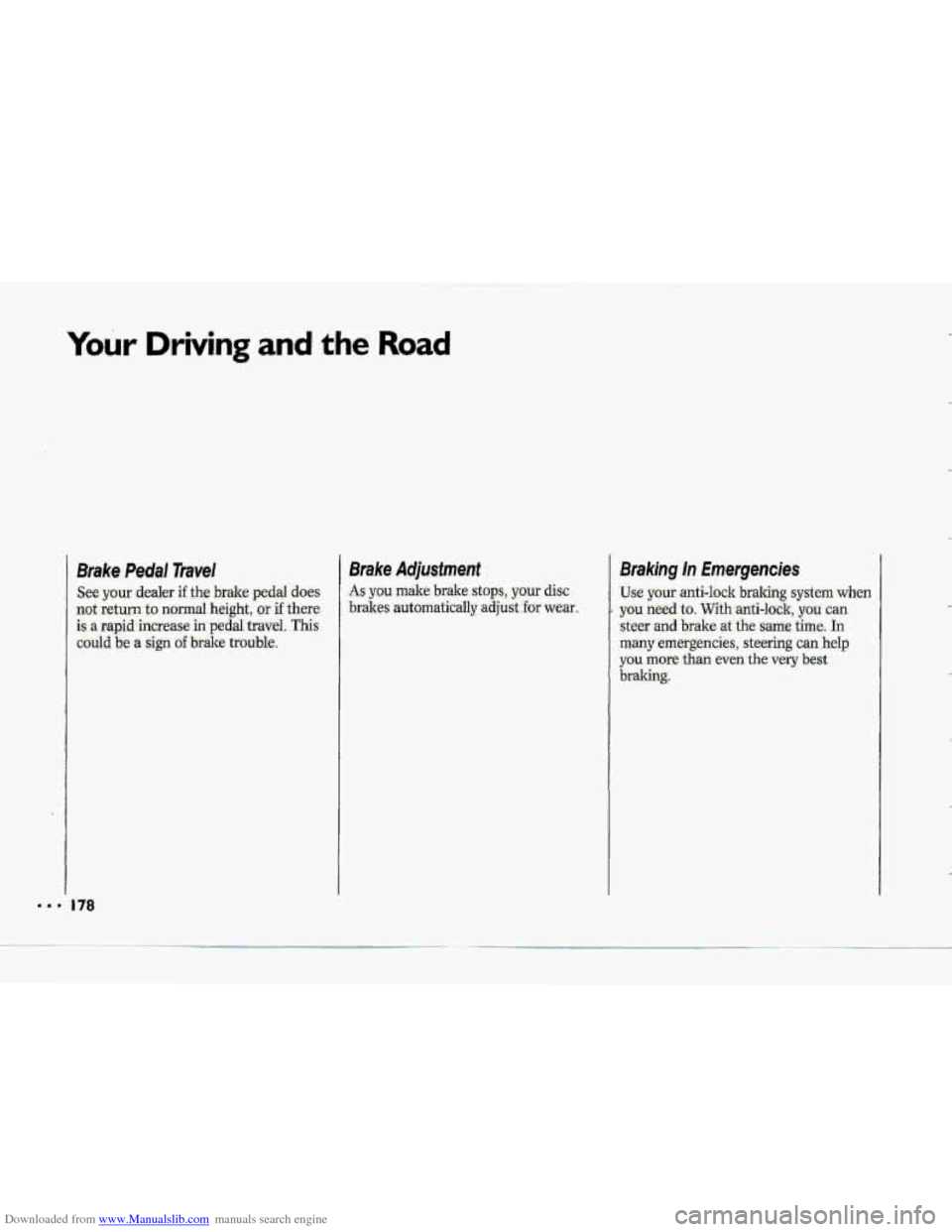
Downloaded from www.Manualslib.com manuals search engine --
Your Driving and the Road
Brake Pedal Travel Brake Adjustment
See your dealer if the brake pedal does
not return to normal height, Qr if there
AS you make brake stops, your disc
couid be a sign of brake trouble
is
a rapid- increase in pedal travel. This
brakes automatically adjust .for wear. , .. .
178
Braking In Emergencies
Use your .anti-lock braking system when
you-need to. With,anti-lock, you can
steer and brake at the same time.. In
many.emagencies, steering can help
you more than even the very best
braking;.
Page 180 of 370
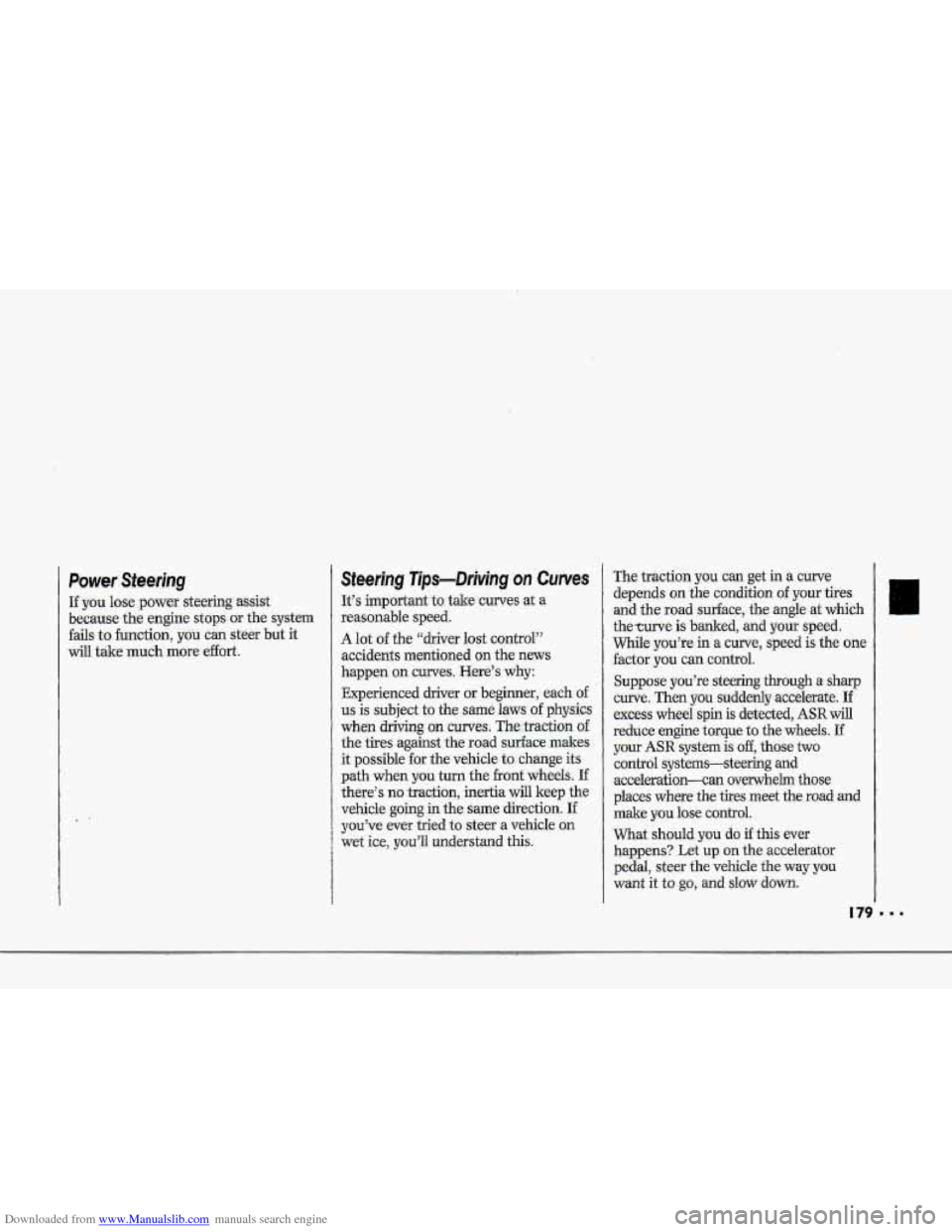
Downloaded from www.Manualslib.com manuals search engine r" i
'4
f
-/_
i
t-
i
Power Steering
If you lose power steering assist
because the engine stops
or the system
fails to function, you c-an steer but it
will take much more effort.
i.
steering Tips-Dtiving on Curves
It's important to tale curves at a
reasonable
speed.
A lot of the "driver lost control"
accidents mentioned
on. the news
happen on .curves. .Here's why:
Experienced driver
or beginner, each of
us is subject to the same laws of physics
when
driving on'curves; The.;traction of
the tixes against the road surface makes
it possible
for the vehicle to change its
path when you turn the front wheels. If
there's no traction, inertia will keep the
vehicle going in the same direction. If
yuu"ve mer tried to steer a vehicle on
wet ice> you:U understand this.
The traction you can get in a curve
depends on the condition of your tizies
and
the road surface, the angle at which
the-curve
is banked, and your speed,
While you're in
a curve, speed is the one
factor you can control.
Suppose you're steering through. a. sharp
a.xve. Then you suddenly acwlerate. If
excess wheel spin is detected, ASR will
reduce erigine torque to the wheels. Lf
your ASR system is off, those two
control systems-steering and
acceleration-can ovGrwhelm those
i places where-the tires meet the road and
~ make you lose control.
1 What should you do if this ever
happens? Let
up on the accelerator
pedal, steer
the vehicle the way you
want it to go, and slow down.
Page 181 of 370
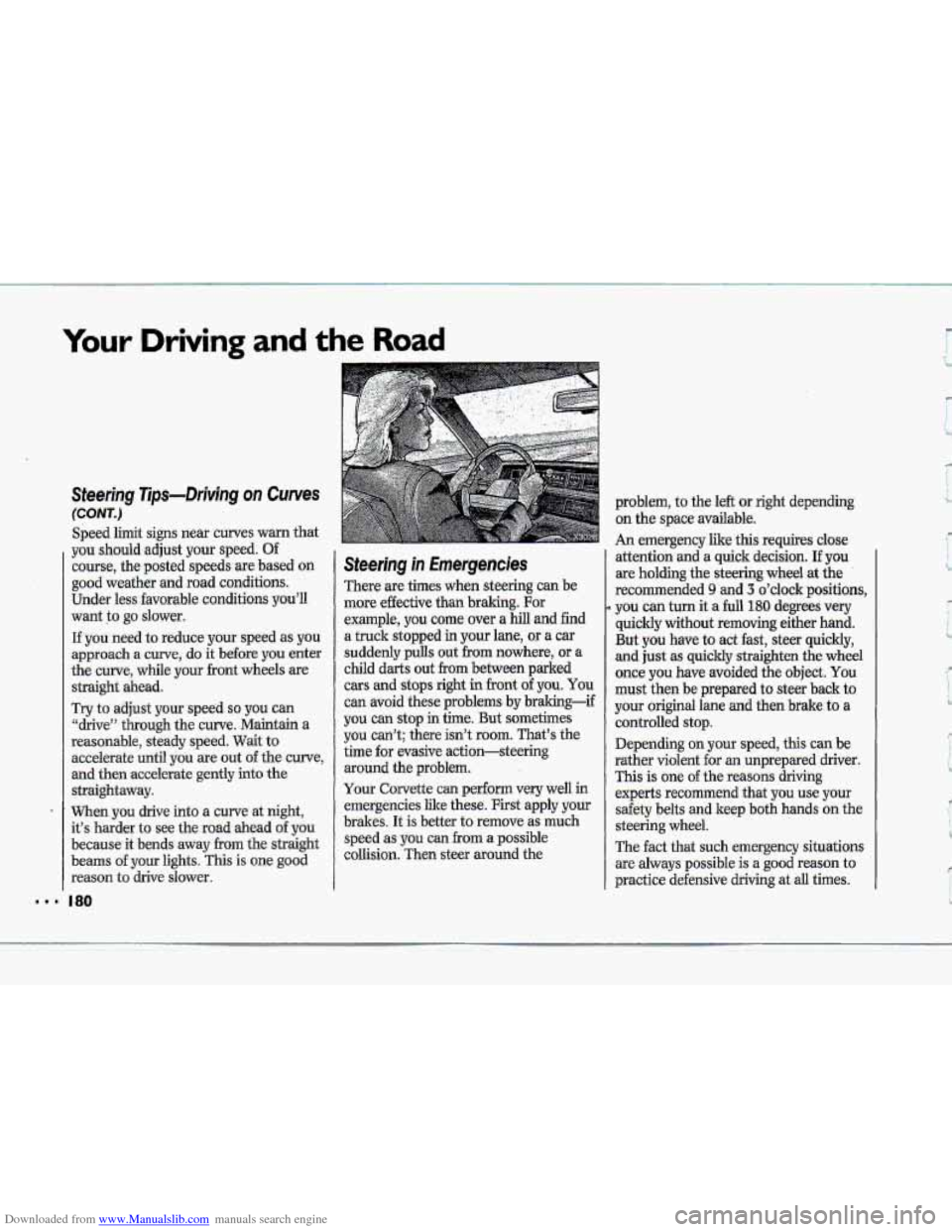
Downloaded from www.Manualslib.com manuals search engine ..I
Your Driving and the Road
’I
Steering Tips-Driving on Curves
(CONT.)
Speed limit signs near curves warm that
you should adjust your speed.
Of
course, the posted speeds are based on
good weather and road conditions.
Under less favorable conditions you’ll
want to
go slower.
If you need to reduce your speed as you
approach
a curve, do it before you enter
the curve, while your hont wheels are
straight ahead.
Try
to adjust your speed so you can
Wive” through the curve. Maintain a
reasonable, steady speed. Wait to
accelerate until you are out
of the curve,
and then accelerate gently into the
straightaway.
When you drive into
a curve at night,
it’s harder to see the road ahead
of you
because it bends away
from the straight
beams
of your lights. This is one good
reason to drive slower.
I80
Steering in Emergencies
There are times when steering can be
more effective than braking. For
example,
you come over a hill and find
a truck stopped
in your lane, or a car
suddenly pulls out
€ram nowhere, or a
child darts out from between parked
cars and stops right in front of you. You
can avoid these problems by braking-if
you can stop in time. But sometimes
you can’t; there isn’t
room. That’s the
time for evasive action-steering
around the problem.
Your Corvette
can perform very well in
emergencies like these. First apply your
brakes. It is better
to remove as much
speed as you can
from a possible
collision. Then steer around the
9
problem, to the left or right depending
on the space available.
An emergency like this requires close
attention and a quick decision.
If you
are holding the steering wheel at the
recommended
9 and 3 o’clock positions,
you can turn it a full 180 degrees very
quickly without removing either hand.
But you have to act fast, steer quickly,
and just as quickly straighten the wheel
once
you have avoided the object. You
must then be prepared to steer back to
your original lane and then brake to a
controlled stop.
Depending on your speed, this can be
rather violent for an unprepared driver.
This is one of the reasons driving
experts recommend that you use your
safety belts and keep both hands
on the
steering wheel.
The fact that such emergency situations
are always possible is
a good reason to
practice defensive driving at
all times.
Page 182 of 370
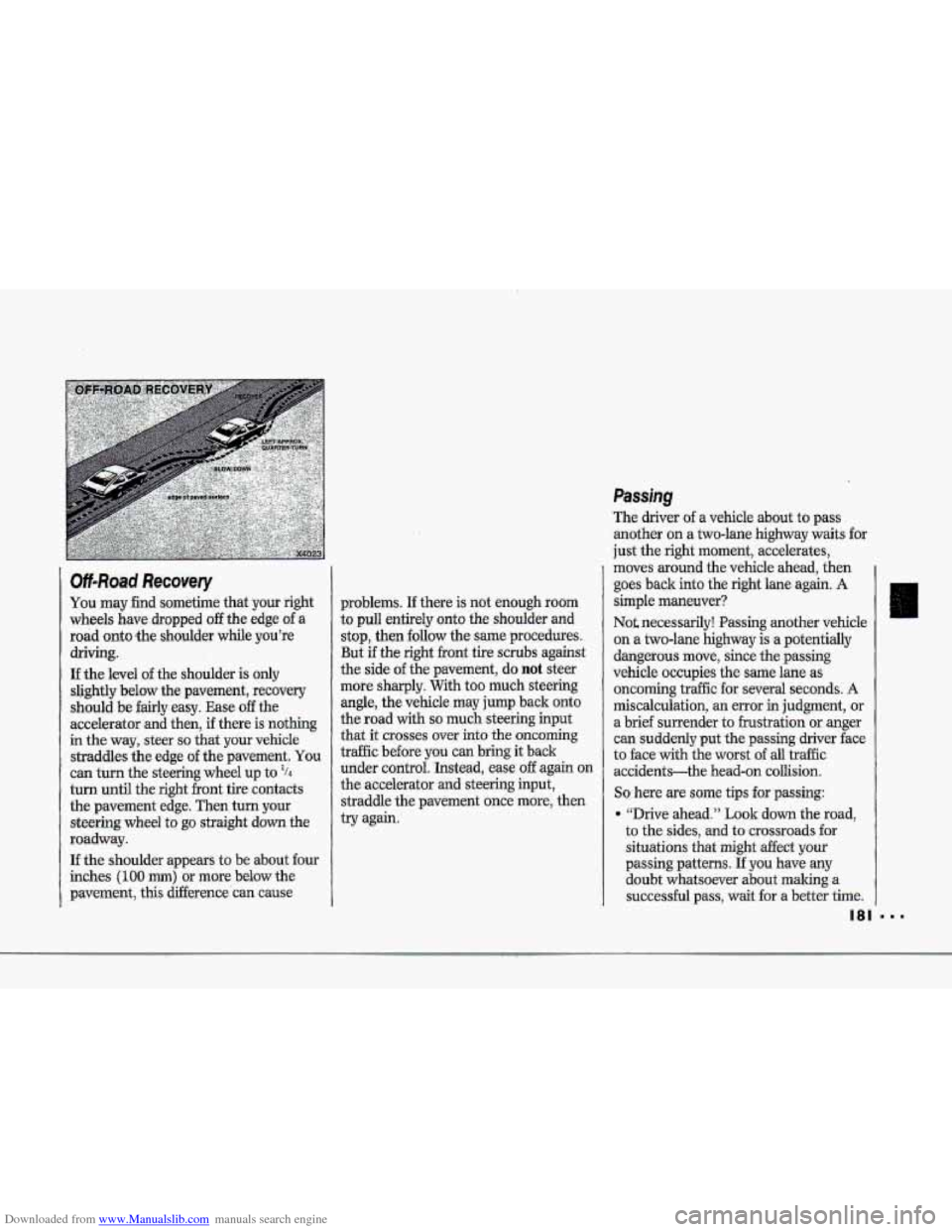
Downloaded from www.Manualslib.com manuals search engine T
i
,+
I i
r.
!
Ofl-Road .Recovery
You may hd sometime that your right
wheels bave dropped 08 the edge of-a
road mtwthe &odder while you’re
driving.
ff- the level of the shoulder is only
slightly below the pavement, recovery
should be fairly easy. Ease off the
accelerator and then, if there is nothing
in the way, steer so that. your%Wde
straddles the edge of. the pavement. You
can turn the steering wheel up to ‘h
turn until theight. front tire contacts
the pavement
edge. Then turn your
stetking wheel to go straight dm the
rcradway.
If the- shoulder appears to be about four
inches (100 mm) or more below the
pavement,. this difference.cm cause
problems. If there is not boough room
to pull entirely onto the shoulder and
stgp, then fdbw the same procedures.
But if the riglit €rant tire scrubs against
the side. af the pavement, do not skstr
more.sharplyy. With too much steering-
angle, the vehicle may jump back o~to
the road with so much steering input
that it-cmsses over into the oncoming
tr&c ,before you can bring it back
under control.. ;Instead, ease off again an
the? accelerator and steeping input,
straddle
the pavement once more, then
try again.
Page 184 of 370
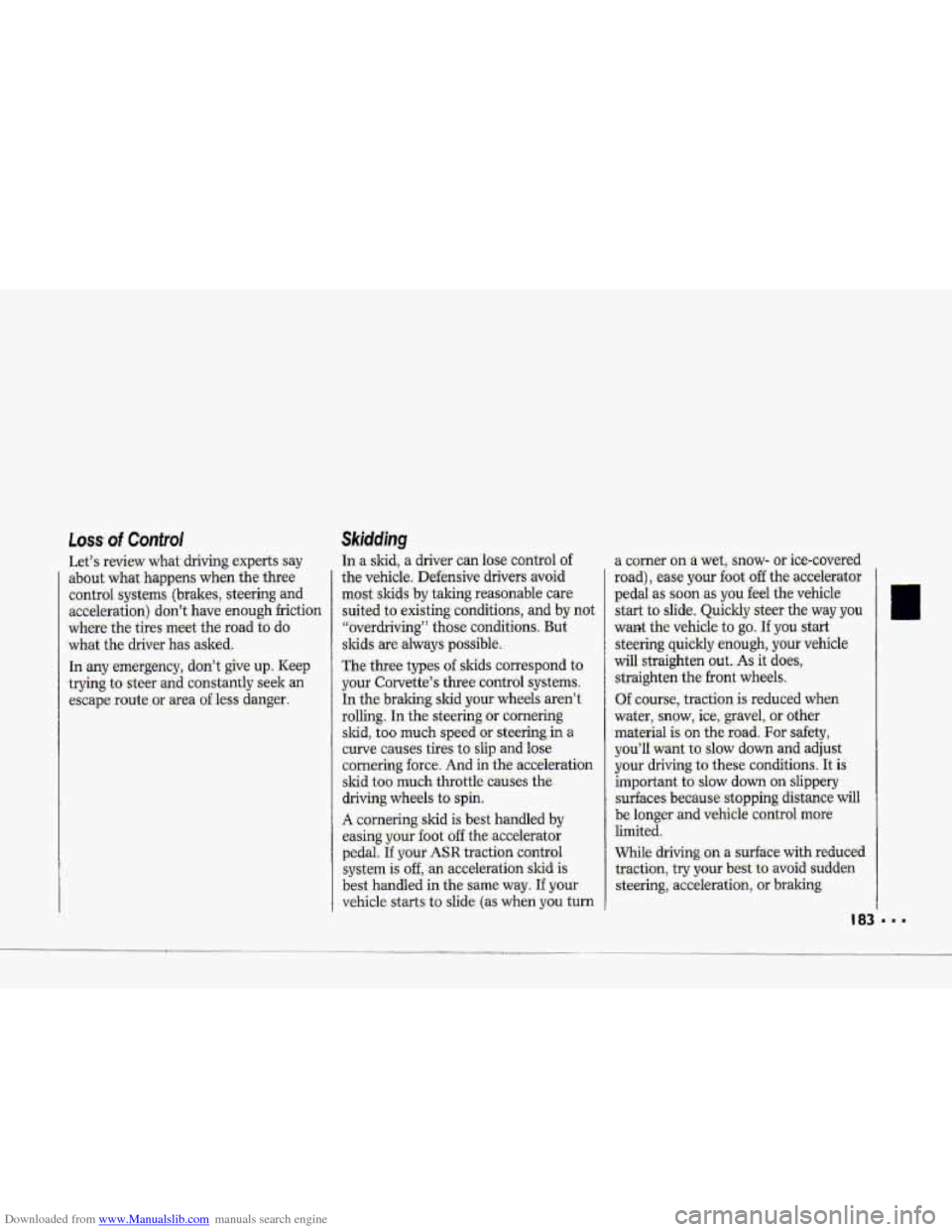
Downloaded from www.Manualslib.com manuals search engine w-
Loss. of Control
Let’s review what- driving experts say
about what ha-ppens when the three
cuntrd systems
(brakes, steering and
acceleration) dodt have enough hictior
where the tires meet the road to do
what the driver has asked,
In any emergency, don’t give up. Keep
trying to- steer and constantly seek an
escape r.oute.oy area of less danger.